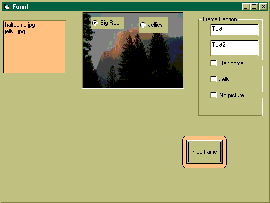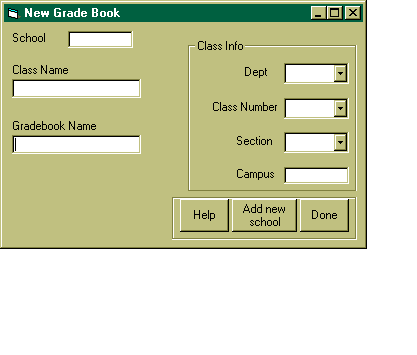Controls
In this example code (containers.zip)
 We create a picturebox control and add some other controls around and in it to
alter the picture it displays.
The picture box control is a container object.
That means that it has properties and methods of its own but also
can contain other controls within it.
You can effect the controls in a container as a group.
Moving the container moves the controls.
You can alter any of the properties that the contained controls
have in common.
We create a picturebox control and add some other controls around and in it to
alter the picture it displays.
The picture box control is a container object.
That means that it has properties and methods of its own but also
can contain other controls within it.
You can effect the controls in a container as a group.
Moving the container moves the controls.
You can alter any of the properties that the contained controls
have in common.
We have an example of another container in this form.
A frame has very few properties.
It's mostly used to give a group of related controls place of their own.
You can reduce the complexity of your forms by collecting
controls into groups based on their function.
In this form from the grade book, the controls concerning
the class information are grouped together.

Another cause for using frames is to collect option buttons together.
Option buttons act as a group.
That is, if one of them is selected, the others are deselected.
All the option buttons on the page are related.
You can have separate groups of options by putting them in frames.
Since frames can be made without a border or caption, they can be invisible.
To put things in a frame, you have two choices.
You can create the frame first and then create the controls inside
it or you can cut and paste existing controls into the frame.
You can't simple drag and drop the controls.
The controls must fit into the frame, so adjust the sizes to fit.
The BASIC Language
The programming elements to be discussed in here are loops, selects
and file handling.
Loops
VB supports several kinds of loop structures.
The first we will see is the standard for loop.
Here are some examples with the equivalent C code for comparison.
Dim i as Integer
For i = 3 To 18 Step 3
Debug.print "i is " & Cstr(i)
Next i
|
for(int i=3; i<=19; i += 3)
{
cout << "i = " << i << endl;
} // end for
|
Dim i as Integer
For i = 20 To -2 Step -1
Debug.print "i is " & Cstr(i)
Next i
|
for(int i=20; i>=-2; i--)
{
cout << "i = " << i << endl;
} // end for
|
Dim i as Integer
For i = 0 To 10
Debug.print "i is " & Cstr(i)
Next i
|
for(int i=0; i<=10; i++)
{
cout << "i = " << i << endl;
} // end for
|
There are couple of kinds of do loops as well.
Dim i as Integer
i = 0;
Do While i < 3
Debug.print "i is " & Cstr(i)
i = i + 1
Loop
|
int i = 0;
while(i<3)
{
cout << "i = " << i << endl;
i++;
} // end while
|
Runs 0 or more times |
Dim i as Integer
i = 0;
Do
Debug.print "i is " & Cstr(i)
i = i + 1
Loop While i < 3
|
int i = 0;
do
{
cout << "i = " << i << endl;
i++;
} while(i<3)
|
Runs 1 or more times |
Dim i as Integer
i = 0;
Do Until i > 3
Debug.print "i is " & Cstr(i)
i = i + 1
Loop
|
int i = 0;
while(i<=3 )
{
cout << "i = " << i << endl;
i++;
}
|
Runs 0 or more times |
The for each loop doesn't have a direct equivalent in C.
It is very useful when dealing with collections of things like arrays.
Dim num as Variant
Dim myarray as Variant
myarray = Array(4,5,6,7)
For Each num In myarray
Debug.print "num is " & Cstr(num)
Next num
const int SIZE=4
int num, myarray[SIZE] = {4,5,6,7}
for (int i = 0; i < SIZE; i++) {
num = myarray[i];
cout << "num is " << num << endl;
} // for
Select
This is like the switch in C but more flexible.
The general form looks like:
Select Case value
case val1
code for val1
case val2
code for val2
case val3
code for val3
case else
code for everything else
end select
A bit like
switch(c ) {
case v1:
code for v1
break;
case v2:
code for v2
break;
case v3:
code for v3
break;
default:
code for everything else
break;
} // end switch
But, the values can only be integers or characters and
the case only checks equality.
In the select case statement, there are other possible comparisons.
Like these from the select code example (select.zip):
Dim i As Integer
i = CStr(Text1.Text)
Select Case i
Case Is < 2
Label1.Caption = "i is less than 2"
Case 2
Label1.Caption = "i is 2"
Case 3, 4, 5
Label1.Caption = "i is 3 or 4 or 5"
Case 6 To 10
Label1.Caption = "i is between 6 and 10, inclusive"
Case Else
Label1.Caption = "i wasn't caught be any of the above"
End Select
Programming Notes
 We create a picturebox control and add some other controls around and in it to
alter the picture it displays.
The picture box control is a container object.
That means that it has properties and methods of its own but also
can contain other controls within it.
You can effect the controls in a container as a group.
Moving the container moves the controls.
You can alter any of the properties that the contained controls
have in common.
We create a picturebox control and add some other controls around and in it to
alter the picture it displays.
The picture box control is a container object.
That means that it has properties and methods of its own but also
can contain other controls within it.
You can effect the controls in a container as a group.
Moving the container moves the controls.
You can alter any of the properties that the contained controls
have in common.
